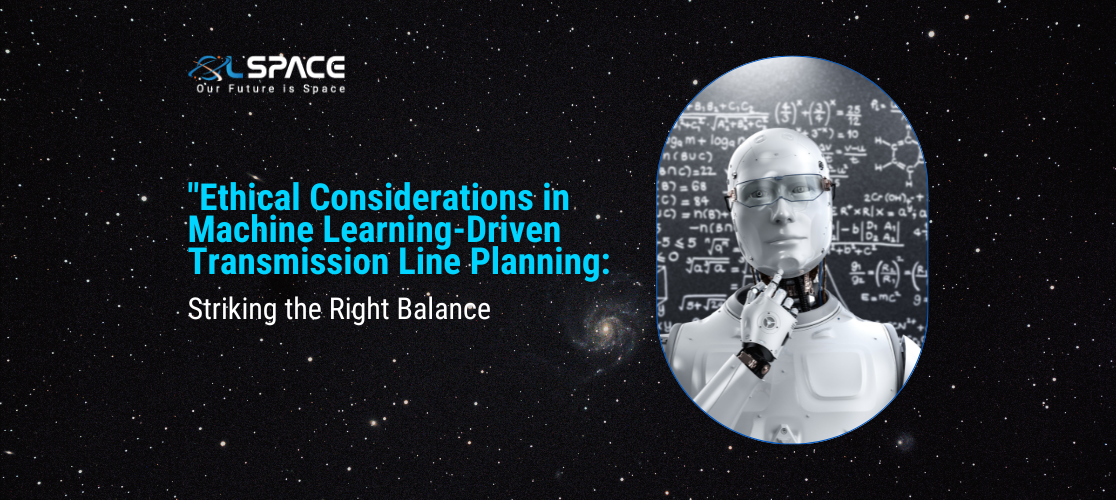28 November 2023
Ethical Considerations in Machine Learning-Driven Transmission Line Planning: Striking the Right Balance

The integration of machine learning (ML) into transmission line planning processes brings about numerous advantages, such as improved efficiency, cost-effectiveness, and enhanced decision-making. However, as with any technology, it also introduces ethical considerations that must be carefully addressed to ensure responsible and sustainable practices. This article explores the ethical dimensions of machine learning-driven transmission line planning and emphasises the importance of striking the right balance between technological innovation and ethical principles.
1. Data Privacy and Security:
Challenge: Machine learning relies on vast datasets, raising concerns about the privacy and security of sensitive information.
Striking the Right Balance: Implement robust data anonymisation and encryption techniques to safeguard personal and sensitive data. Develop clear data governance policies, ensuring compliance with privacy regulations such as GDPR or HIPAA. Transparently communicate data handling practices to stakeholders.
2. Bias and Fairness:
Challenge: Machine learning algorithms may inadvertently perpetuate biases present in historical data, leading to unfair outcomes.
Striking the Right Balance: Regularly audit and evaluate machine learning models for bias. Introduce fairness-aware algorithms and mitigation strategies to address biases in data. Foster diversity and inclusivity in the development team to promote a broader perspective on potential biases.
3. Accountability and Transparency:
Challenge: The opacity of complex machine learning models may hinder accountability and transparency in decision-making.
Striking the Right Balance: Prioritise transparency by adopting interpretable ML models and providing clear documentation on model decision-making processes. Establish accountability frameworks that outline responsibilities and liabilities in case of unintended consequences. Encourage open communication with stakeholders.
4. Environmental Impact:
Challenge: Training and deploying machine learning models can have a significant environmental impact, especially if powered by energy-intensive computing systems.
Striking the Right Balance: Optimise ML algorithms for efficiency and explore energy-efficient computing solutions. Implement sustainability practices, such as utilising renewable energy sources for model training and deployment. Balance the environmental impact against the benefits derived from improved transmission line planning.
5. Community Engagement:
Challenge: Lack of community involvement in decision-making processes may lead to mistrust and opposition to ML-driven transmission line planning.
Striking the Right Balance: Prioritise community engagement and involve stakeholders in the development and deployment of ML models. Establish clear communication channels to address concerns and provide information on the benefits and risks associated with the technology. Consider the local context and cultural sensitivities.
6. Job Displacement:
Challenge: Automation through machine learning may lead to job displacement for certain roles in the planning process.
Striking the Right Balance: Proactively address workforce transition by providing training and upskilling opportunities for individuals affected by automation. Consider the ethical implications of job displacement and work towards creating a balance between technological advancement and employment sustainability.
7. Long-Term Impact Assessment:
Challenge: Predicting the long-term impact of machine learning-driven transmission line planning on communities and ecosystems can be challenging.
Striking the Right Balance: Establish continuous monitoring and assessment mechanisms to evaluate the long-term social, economic, and environmental impact of ML applications. Adapt models and strategies based on ongoing evaluations to mitigate negative consequences and enhance positive outcomes.
8. Regulatory Compliance:
Challenge: Evolving regulatory landscapes may pose challenges in ensuring ML-driven transmission line planning adheres to ethical standards.
Striking the Right Balance: Stay informed about emerging regulations related to AI and machine learning. Proactively align ML practices with ethical guidelines and legal requirements. Engage in industry collaborations to contribute to the development of ethical standards.
Conclusion: Toward Ethical Machine Learning in Transmission Line Planning
As machine learning continues to revolutionise transmission line planning, ethical considerations must be at the forefront of decision-making. Striking the right balance involves a commitment to transparency, fairness, community engagement, and ongoing ethical assessments. By addressing these challenges head-on, stakeholders can ensure that machine learning-driven transmission line planning not only maximises technological benefits but also aligns with ethical principles, fostering sustainable and responsible practices for the future.
